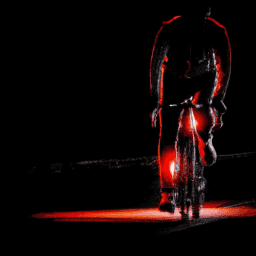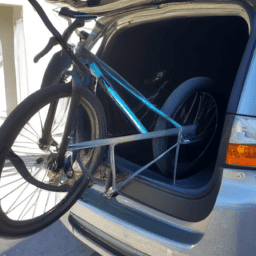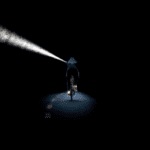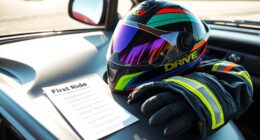As a passionate bicyclist, I’ve come across numerous suggestions on the optimal approach to nighttime cycling. Some argue in favor of donning vivid colors, whereas others advocate for the installation of lights on your bicycle.
But what’s the truth? As it turns out, there are several important measures you should take when riding a bicycle at night to ensure your safety on the road.
First and foremost, it’s crucial to wear reflective clothing and accessories when cycling at night. This is because reflective materials help drivers see you from a distance, even in low light conditions. Whether it’s a reflective vest, ankle bands, or a helmet with reflective stickers, these accessories can make all the difference in preventing accidents on the road.
But reflective gear is just one part of the equation – there are several other tips and tricks you should keep in mind to stay safe when cycling at night.
Key Takeaways
- Wear reflective clothing and accessories and use reflective strips or patches for visibility
- Attach lights to your bike with white light on front and red light on back
- Follow traffic rules, use hand signals, and leave enough space between yourself and other vehicles
- Regularly check and maintain your bike, including tire inflation, brakes, lights, and chain lubrication.
Wear Reflective Clothing and Accessories
You gotta make sure to wear reflective gear when biking at night, so you can be seen by drivers and stay safe on the road! Choosing reflective materials is important because they can make you visible from a distance.
Look for clothing and accessories that have reflective strips or patches, as these are the most effective in reflecting light. It’s also important to consider visibility in different weather conditions. For example, if it’s raining, you may want to wear a waterproof reflective jacket to ensure that you’re visible in the rain.
In addition to wearing reflective clothing and accessories, it’s important to attach lights to your bike. Lights not only help you see where you’re going, but they also make you visible to drivers. So, make sure your bike has a white light on the front and a red light on the back.
By wearing reflective gear and attaching lights to your bike, you can ensure that you’re seen by drivers and stay safe while biking at night.
Attach Lights to Your Bike
Don’t forget to fasten your bike lights before hitting the road after sunset! There are different types of bike lights that you can use to increase your visibility and safety while riding at night.
The most common types are headlight and taillight. A headlight illuminates the road ahead, allowing you to see where you’re going. A taillight, on the other hand, makes you visible to other road users from behind.
Proper installation techniques are crucial to ensure that your bike lights are securely fastened to your bike. The headlight should be mounted on the handlebars, while the taillight should be attached to the seat post or rear rack. Make sure that the lights are facing in the right direction and are not obstructed by any other accessories or parts of the bike.
With the right type of bike lights and proper installation techniques, you can ride confidently and safely at night.
Remember, attaching lights to your bike is just one step towards safe night riding. It’s important to also follow traffic rules and be aware of your surroundings while on the road.
Follow Traffic Rules
When following traffic rules on your bike, it’s important to be aware of your surroundings and anticipate potential hazards. Obeying laws such as stopping at red lights and signaling before turning can not only prevent accidents but also earn you respect from other road users. Proper signaling allows drivers and pedestrians to understand your intentions and react accordingly.
Always use hand signals to indicate turns and stops, and make sure to leave enough space between you and other vehicles. Remember that you’re a part of traffic and should behave accordingly.
Additionally, staying alert is crucial when riding at night. Keep an eye out for cars and other bicycles, as well as pedestrians and animals that may be difficult to see. Stay visible by wearing reflective clothing and using lights on your bike. Always assume that drivers can’t see you and take extra caution when approaching intersections.
By following traffic rules and staying alert, you can ensure a safe and enjoyable ride.
Stay Alert
As a cyclist, staying alert is crucial when riding at night. It helps you stay aware of your surroundings, avoid accidents, and arrive at your destination safely.
To stay alert, I follow a few tips such as watching out for road hazards, using reflective gear, and avoiding distractions like headphones or mobile phones.
Importance of Staying Alert
Remaining vigilant while cycling at night is like being a sentry guarding a castle, always aware and ready for any potential danger. As a cyclist, I know the importance of staying alert as it can be a matter of life and death.
Fatigue and dehydration are two major factors that can affect your alertness and reaction time while cycling at night. Even a small lapse in concentration can lead to a serious accident.
Fatigue can cause a cyclist to feel drowsy and lose focus on the road. It can also slow down reaction time, making it difficult to avoid obstacles or react to sudden changes.
On the other hand, dehydration can lead to tiredness and dizziness, which can affect one’s ability to control the bike. Therefore, staying alert and hydrated during the ride is critical to ensure a safe and enjoyable night cycling experience.
In the following paragraphs, I’ll share some tips on how to stay alert while cycling at night.
Tips to Stay Alert When Riding at Night
To keep your senses sharp during a nocturnal ride, try sipping on water every few minutes and taking deep breaths of the cool, crisp air. The importance of hydration cannot be overstated, especially when cycling at night. Dehydration can cause fatigue, dizziness, and loss of focus, all of which can be dangerous while riding. Additionally, choosing appropriate routes is crucial for staying alert. Avoid busy roads with heavy traffic and opt for well-lit paths or bike lanes whenever possible. This will help reduce distractions and allow you to focus on the road ahead.
To further ensure your safety, there are additional measures you can take to stay alert and aware. These include wearing reflective clothing, using bike lights, and remaining vigilant for potential hazards such as potholes or debris on the road. By taking these precautions, you can enjoy a peaceful and safe ride at night.
Additional Safety Measures
When I ride my bicycle at night, I always take additional safety measures to ensure my well-being on the road. First, I make sure to use bike lanes or paths whenever possible to stay away from traffic.
Second, I avoid any distractions like listening to music or using my phone while riding.
Finally, I always check my bike before setting out to make sure everything is working properly, especially the lights and reflectors.
These simple but effective measures help me feel confident and safe while cycling at night.
Use Bike Lanes or Paths
Using bike lanes or paths is essential for safe nighttime cycling, as it helps to reduce the risk of collisions with other vehicles. Bike lanes are designated areas on the road for cyclists to ride in, while bike paths are separate from the road and provide a safer, more scenic route. There are many benefits to using bike lanes or paths, including increased visibility for drivers and the ability to avoid obstacles on the road. However, there are also safety concerns to be aware of when using these routes.
Benefits of bike lanes include the fact that they are often well-lit and clearly marked, making it easier for drivers to see cyclists. In addition, bike lanes are usually wider than the shoulder of the road, which provides more space for cyclists to ride safely. On the other hand, bike paths can be more secluded and may not be as well-maintained as bike lanes. Cyclists using bike paths should be aware of their surroundings and use caution when riding around curves or blind spots.
Overall, using bike lanes or paths is an important safety measure when cycling at night. However, it is important to be aware of the potential hazards that come with these routes and to take precautions accordingly. In the next section, I will discuss how to avoid distractions while cycling at night.
Avoid Distractions
Stay focused and enjoy the ride by avoiding distractions while cycling at night! Keeping focus is crucial when riding a bicycle at night, as the lack of visibility makes it harder to react to unexpected situations.
Here are three things you can do to minimize distractions and improve your safety:
-
Leave the headphones at home. Listening to music or podcasts might be a great way to pass the time during a long ride, but it can also prevent you from hearing important sounds such as approaching cars or pedestrians.
-
Turn off your phone or put it on silent mode. Notifications, calls, and text messages can be distracting, and you don’t want to take your eyes off the road to check your device.
-
Avoid talking to other cyclists or pedestrians. While it’s nice to be social, striking up a conversation while cycling can be dangerous. Not only does it take your attention away from the road, but it can also make it harder for you to hear other important sounds.
By minimizing noise and distractions, you can stay alert and focused while cycling at night. Now that you know how to avoid distractions, let’s move on to the next step: checking your bike before riding at night.
Check Your Bike Before Riding at Night
Before heading out on your nighttime ride, make sure to give your bike a thorough check to ensure its safety and your own. This step is crucial in preventing any unexpected issues that may arise while you are cycling in the dark. The importance of maintenance cannot be stressed enough, especially when it comes to ensuring your bike is in top condition for a night ride.
Common bike issues that can occur during a nighttime ride include flat tires, loose brakes, and malfunctioning lights. To avoid these problems, it is important to check your tires for proper inflation, inspect your brakes for any looseness or worn out brake pads, and ensure that all your lights are functioning correctly. A simple check before heading out on your ride can save you from potential accidents and ensure an enjoyable, safe experience. Use the table below as a quick reference guide to ensure your bike is ready for a nighttime ride.
| Bike Check | Importance | Common Issues |
|---|---|---|
| Tire Inflation | Prevents flats and improves grip | Low pressure, punctures |
| Brake Inspection | Ensures proper stopping power | Loose brakes, worn out brake pads |
| Light Check | Increases visibility | Malfunctioning lights, dead batteries |
| Chain Lubrication | Improves performance and longevity | Dirty or dry chain, rusted links |
Taking the time to check your bike before riding at night is essential for your safety and the safety of others. By ensuring that your bike is in top condition, you can avoid common bike issues and enjoy a smooth, worry-free ride. Remember to regularly maintain your bike to ensure its longevity and optimal performance.
Frequently Asked Questions
How bright should my bike lights be when riding at night?
When riding at night, lighting intensity and battery life are important factors to consider for bike lights. I recommend using lights with at least 200 lumens and a battery life of at least 4 hours for optimal visibility and safety on the road.
Are there any specific types of reflective clothing that are better for night riding?
The best materials for reflective clothing are those that reflect light well, such as fluorescent colors and reflective tape. Reflective stickers on clothing can also be effective.
What should I do if I encounter a driver who doesn’t seem to see me on my bike?
If I encounter an oblivious driver while biking on busy roads, I stay visible with reflective clothing and hand signals. I also use bike lanes and avoid distractions. Vigilance and caution help me stay safe.
Can I use a headlamp instead of a bike light for night riding?
Choosing between a headlamp and bike light for night riding is like choosing between a flashlight and a lighthouse. While a headlamp may suffice, legal requirements mandate a bike light. So, invest in a quality bike light.
Are there any special precautions I should take when riding on rural roads at night?
For nighttime visibility and rural road safety, I wear reflective clothing and attach reflective gear to my bike. I also use front and rear lights, and avoid distractions. I always stay alert for cars and animals on the road.
Conclusion
So, when it comes to riding a bicycle at night, safety should be your top priority.
Reflective clothing and accessories, such as a vest or ankle straps, will make you more visible to drivers on the road. Additionally, attaching lights to your bike, both in the front and back, will make it easier for drivers to see you from a distance.
It’s important to remember to follow traffic rules and stay alert, especially when riding at night. By being aware of your surroundings and anticipating potential hazards, you can avoid accidents and enjoy a safe ride.
With these additional safety measures in mind, you can confidently hit the road and enjoy a peaceful and enjoyable ride under the stars.
















